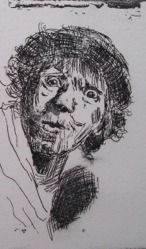
Electro-‐etching, or galv-‐etch, is an electrical etching technique which can be practised conveniently and safely at home without the need for expensive equipment. For example, a copper plate 100 mm x 150 mm* prepared for etching in the usual way and with (say) a needled line image, can be battery, another copper plate of a similar size, a couple of metal wires with connectors, an on/off switch, a plastic food container of around a litre capacity and an electrolyte -‐ a liquid through which an electric current can flow, in this case some copper sulphate crystals dissolved in tap water.
To etch the copper plate, the two plates are held vertically in the electrolyte, facing one another and separated by about 50 mm. The battery and switch are connected between the two plates (electrodes), with the positive terminal attached to the plate which is to be etched and the negative terminal to the other copper plate; when the switch is closed electric current flows and etching takes place.
Unfortunately, the mere mention of using electricity appears to intimidate some artist-‐printmakers and deters them from using this method of etching: perhaps they think that a high level of electrical expertise or a scientific background is required. Neither is true. As other articles on this website and the new English edition of the book -‐etching handbook a safe, non-‐ by Alfonso Crujera show, the practical application of the technique is generally straight forward.
Two “giants” of science started their working lives in professions closer to home: Benjamin Franklin, scientist, diplomat and statesman ran a successful printing business and throughout his life continued to sign himself “Benjamin Franklin, printer”; Michael Faraday, regarded by Einstein as one of the greatest experimental scientists of all time, began as an apprentice bookbinder.
This article presents some of the underlying ideas and terminology connected with electro-‐ etching. It is not crucial to understand these principles in order to produce successful etchings. However, we believe that by presenting a simplified explanation, it may remove some of the mystery of the technique and assist in encouraging its wider use.
* Plates and images shown in article are based on this size
NEXT - Part 1 - Background